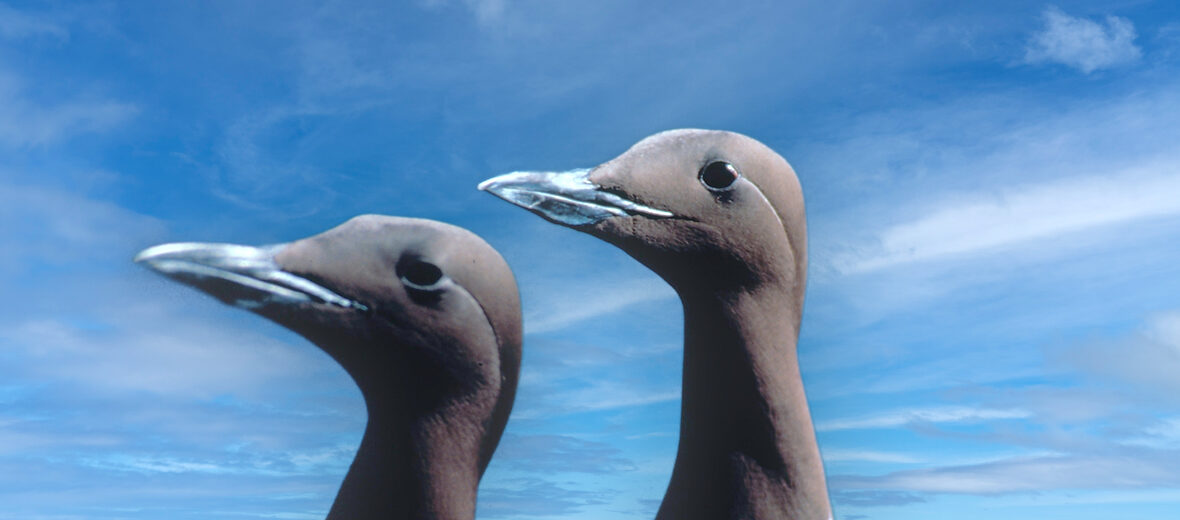
The common murre, aka common guillemot, is a large species of auk that can be found in the northern Pacific Ocean and northern Atlantic Ocean. They spend most of their lives out at sea, only coming to shore to breed. These birds face the threats of hunting; trapping; overfishing; land pollution; water pollution; microplastics pollution; and climate change, that can cause severe weather patterns. Fortunately, these birds are abundant enough to be listed as Least Concern by the IUCN. Their population trend is also increasing. However, there are mass die-offs in several parts of their range.
First the Stats…
Scientific name: Uria aalge
Weight: Up to 2.12 lbs.
Length: Up to 18 inches
Wingspan: Up to 29 inches
Lifespan: Up to 30 years
Now on to the Facts!
1.) They were originally described and illustrated in 1763 by the Danish bishop Erik Pontoppidan.
2.) There are 5 subspecies recognized: U. a. hyperborea, U. a. albionis, U. a. inornata, U. a. californica, and U. a. aalge.
3.) These auks can reach flight speeds of up to 50 mph.
4.) Being a pursuit-diver they forage for food by swimming underwater using their wings for propulsion. Dives usually last less than 2 minutes.
5.) In Alaska, between 2014 – 2016, a marine heat wave killed off half the murre population, and as of 2024 the species still has yet to recover.
But wait, there’s more on the common murre!
6.) Cape Meares, Oregon is home to 1 of the most populated colonies of nesting common murres on the North American continent.
7.) These auks consume up to 1.125 lbs. of food a day. If they go for 3 – 5 days+ without food, they will perish.
Did you know…?
While fast, yet not very agile in flight, these birds are incredible swimmers and can dive to depths of up to 590 feet!
8.) Polar cod, capelin, sand lances, sprats, sandeels, Atlantic cod, and Atlantic herring are all feasted upon; as long as they’re 8 inches or less in length. Mollusks, marine worms, squid, and crustaceans (like amphipods) are also on the menu.
9.) Courtship displays including billing (rubbing their bills together), bowing, and mutual preening (grooming each other). The male will also point his head vertically and produce croaking and growling sounds to attract a female.
10.) Nesting colonies are massive and densely packed, with the birds often touching one another.
But wait, there’s still more on the common murre!
11.) They are monogamous (mate for life), but pairs will split up if breeding is unsuccessful.
12.) Females lay a single egg and incubate it on top of their feet and under their body for up to 30 days.
Did you know…?
Much to these bird’s dismay, eggers from San Francisco took nearly 500,000 eggs a year from the Farallon Islands in the mid-19th century to feed the growing city.
13.) The egg is large, up to 11% of the female’s total weight!
14.) Both parents switch off between brooding the chick and foraging for food.
15.) Nesting birds are prone to 2 primary sources of recreational disturbances: rock-climbing and birdwatching. The sea cliffs are a haven for climbers as well as for birds; a small island like Lundy has over 1,000 noted climbing routes.
Now a Short Common Murre Video!
Be sure to share & comment below! Also, check out the Critter Science YouTube channel. Videos added regularly!

Want to suggest a critter for me to write about? Let me know here.
Some source material acquired from: Wikipedia & IUCN
Photo credit: Fish & Wildlife Service



